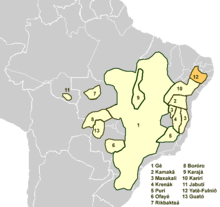Fulniô language
| Yatê-Fulniô | |
|---|---|
| Native to | Brazil |
| Region | Pernambuco |
Native speakers | 1,000 (2011)[1] |
|
Macro-Gê?
| |
| Dialects |
|
| Language codes | |
| ISO 639-3 |
fun |
| Glottolog |
fuln1247[2] |
 | |
Fulniô, or Yatê, is a language isolate of Brazil, and the only indigenous language remaining in the northeastern part of that country. The two dialects, Fulniô and Yatê, are very close. The Fulniô dialect is used primarily during a three-month religious retreat.[3]
The language is also called Carnijó, and alternate spellings are Fornió, Furniô, Yahthe, and Iatê.
Classification
Kaufman (1990) classified Fulniô as one of the Macro-Gê languages. However, Eduardo Ribeiro of the University of Chicago, who is working on large-scale classification of Brazilian languages, finds no evidence to support this, and treats it as an isolate.
Phonology
| Labial | Alveolar | Postalveolar | Palatal | Velar | Glottal | |||||||
|---|---|---|---|---|---|---|---|---|---|---|---|---|
| plain | aspirated | plain | lateralized | aspirated | plain | aspirated | plain | aspirated | ||||
| Stop | voiceless | p | pʰ | t | tʰ | k | kʰ | (ʔ) | ||||
| voiced | d | |||||||||||
| Affricate | voiceless | t͡s | t͡sʰ | t͡ʃ | t͡ʃʰ | |||||||
| voiced | d͡ʒ | |||||||||||
| Fricative | voiceless | f | s | ʃ | h | |||||||
| voiced | z | |||||||||||
| Nasal | m | n | ||||||||||
| Approximant | l | j | w | |||||||||
The glottal stop [ʔ] is considered epenthetic.
| Front | Back | |
|---|---|---|
| Close | i | u |
| Near-close | ɪ | o |
| Open-Mid | ɔ | |
| Near-open | æ | |
| Open | a |
There are few contrasts between /o/ and /u/, suggesting /u/ is a recent addition, perhaps from Portuguese.
All seven have nasalized and glottalized allophones, depending on adjacent consonants. Vowels occur long and short. However, long vowels result from assimilation of /h/, are pronounced [Vh] in one dialect, and so are analyzed as /Vh/ sequences.
Tones are high and low. Contour tones occur allophonically adjacent to voiced consonants. Final syllables tend to lack a tone contrast, and final vowels may be devoiced or dropped.
There are no vowel sequences; vowels either coalesce or are separated by a glottal stop. Consonant clusters are limited to two consonants, apart from a possible additional /j w/, with the maximum syllable being CCCVC; reduced vowels between consonants are analyzed as /j w/ by Meland & Meland: /tfàltʰùlkja/ 'crossing over', /kwlèlja/ 'rotten'.
Bibliography
- Fulniô (Yahthe) Syntax Structure, Meland & Meland (2009 [1968])
- Phonemic Statement of the Fulniô Language, Meland & Meland (2010 [1967])
References
- ↑ Yatê-Fulniô at Ethnologue (19th ed., 2016)
- ↑ Hammarström, Harald; Forkel, Robert; Haspelmath, Martin, eds. (2017). "Fulniô". Glottolog 3.0. Jena, Germany: Max Planck Institute for the Science of Human History.
- ↑ Ethnologue